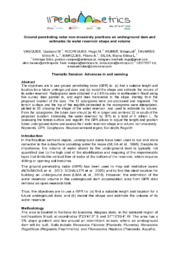Ground penetrating radar non-invasively positions an underground dam and estimates its water reservoir shape and volume.
Ground penetrating radar non-invasively positions an underground dam and estimates its water reservoir shape and volume.
Author(s): VASQUES, G. de M.; RODRIGUES, H. M.; HUBER, E.; TAVARES, S. R. de L.; MARQUES, F. A.; SILVA, M. S. L. da
Summary: The objectives are to use ground penetrating radar (GPR) to: (a) find a suitable length and location for a future underground dam; and (b) model the shape and estimate the volume of its water reservoir. Radargrams were obtained in a 0.85-ha area in northeastern Brazil along five survey lines parallel to, and eight lines transverse to the slope, starting from the proposed location of the dam. The 13 radargrams were pre-processed and migrated. The terrain surface and the top of the regolith delineated in the radargrams were interpolated, plotted in 3D showing the shape of the water reservoir, and used to estimate its volume. From the radargrams, the future dam should be 45 m longer and centered 22 m south of the proposed location, increasing the water reservoir by 50% to a total of 6 million L. By assessing the terrain surface and regolith, the GPR allows to adjust the length and position future underground dams and assess their water reservoir shape and volume non-invasively.
Publication year: 2022
Types of publication: Paper in annals and proceedings
Unit: Embrapa Soils
Keywords: Barragem Subterrânea, Brazilian semiarid region, GPR, Geophysics, Radar, Regolith, Soil depth, Solo
Observation
Some of Embrapa's publications are published as ePub files. To read them, use or download one of the following free software options to your computer or mobile device. Android: Google Play Books; IOS: iBooks; Windows and Linux: Calibre.
Access other publications
Access the Agricultural Research Database (BDPA) to consult Embrapa's full library collection and records.
Visit Embrapa Bookstore to purchase books and other publications sold by Embrapa.

